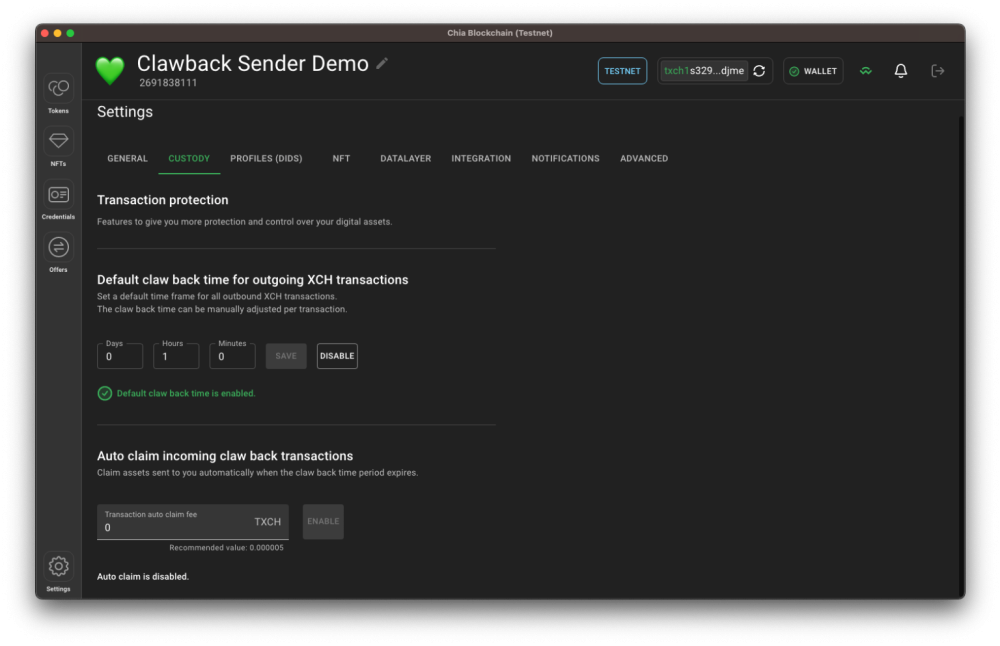
Kopalnie Krypto Team - Friday 30 June 2023
Chia Client Update - Welcome to Version 1.8.2!
The Chia Network developers are working diligently. Thus, the community receives another version of the reference client. The designation 1.8.2 signifies nothing other than highly significant updates. The Clawback mechanism has been implemented within transactions. Support for Verifiable Credentials (VC) has also been introduced. It may sound complicated, but don't worry - we are here to explain.
Clawback mechanism within transactions
Let's start with something easier. So far, cryptocurrency transactions have been associated with a certain amount of stress. When sending funds to someone, you had to double-check that the entered public key (recipient's address) was correct. One mistake, and your coins end up in oblivion or with an unintended person. We are only human, and as we know, humans make mistakes. Even multiple verifications of the address carry the risk of misplacing one digit or letter. Users want a simple and stress-free way of conducting transactions. Thanks to the Clawback mechanism, we no longer have to take responsibility for our mistakes.
Let's focus first on users wanting to send their funds to someone. The Clawback mechanism allows them to withdraw mistakenly made transactions without compromising one of the fundamental characteristics of the blockchain - immutability. In simpler terms, if we send the wrong amount or provide an incorrect wallet address, we can reclaim our funds within a time window that we determine ourselves. Users can configure their wallet so that each transaction can be withdrawn, for example, within an hour of its execution. Naturally, this functionality is not mandatory. The length of the time lock (withdrawal period) can be adjusted according to preferences for individual transactions. The Clawback mechanism itself can also be completely disabled.
Now, let's see what it means for the recipient. In the case of transactions covered by the Clawback mechanism, the recipient does not immediately receive the funds. Instead, they appear on the list of incoming transactions with the appropriate notation. The recipient has insight into the length of the time window, after which they will be able to manually claim their funds. Any transaction that has not been claimed by the recipient can be withdrawn, and the funds will be returned to the sender's wallet. It is essential to observe the list of incoming transactions and regularly claim funds. This way, the balance will be updated, and the assets will ultimately reach the recipient's account. All well and good, but not everyone has the time to regularly check the list of transactions and claim their crypto. Some users may have thousands of queued operations, and multiple clicks on the "Claim" button can lead to wrist deformities. What to do in such a situation? For such users, the auto-claim feature is provided. When enabled in the settings, all funds covered by the Clawback mechanism will be automatically claimed. The only condition is to have the wallet application running. It should be noted that automatic claiming of funds incurs an individually set fee for each transaction.



Source: www.chia.net
Verifiable Credentials (VC)
In the new wallet version, one of the primitives of the Chia blockchain has also been implemented - Verifiable Credentials (VC). They represent statements about data entities (e.g., individuals). These statements are cryptographically verified and tamper-resistant. A verifiable credential must include a trusted network of issuers, holders, and verifiers. This primitive is based on the W3C standard.
That's enough, when it comes to the definition. As is usually the case with them, there are more complex words than understandable content. Let's simplify it. Verifiable Credentials are like digital identity cards that allow users to prove certain information about themselves without revealing too much.

Source: www.chia.net
Above, we mentioned the trusted network of issuers, holders, and verifiers. Who are they, and what are their responsibilities? Let's describe them:
-
Issuer - an entity that creates verifiable credentials regarding another entity.
-
Holder - an entity that the verifiable credential applies to. They are its owner and can freely use and manage it. The VC holder can initiate its withdrawal if the security of their wallet is compromised. This prevents improper use of data in the blockchain.
-
Verifier - an entity that checks the authenticity of verifiable credentials presented by their holder. The verifier fully trusts the issuer of the VC.
We already know what verifiable credentials are. We have also learned that they have been introduced in the new version of the reference client. What functionalities can we expect, then?
With the release of version 1.8.2, VC holders gain access to a list of verifiable credentials assigned to their wallet. They can also view data stored within each VC, including the issuer's DID, issuance date, expiration date, type, version number, metadata, and a constant VC token identifier for audit purposes.
Summary
As you can see, the latest version of the Chia reference client introduces two extremely important features. The first one, the Clawback mechanism, safeguards stress-free transaction execution, where mistakes are not something to fear. The second functionality, Verifiable Credentials (VC), expands the Chia ecosystem, going far beyond the financial system. Looking at the development of the Chia Network, one might get the impression that the technology being created as part of the project will revolutionize not only the way we manage our assets but also the entire information circulation system.





















